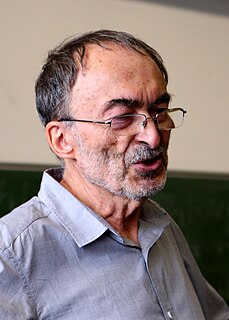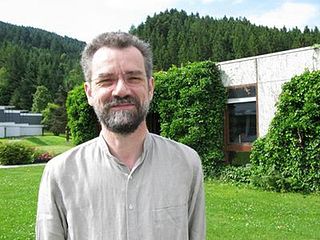In number theory, Iwasawa theory is the study of objects of arithmetic interest over infinite towers of number fields. It began as a Galois module theory of ideal class groups, initiated by Kenkichi Iwasawa (1959), as part of the theory of cyclotomic fields. In the early 1970s, Barry Mazur considered generalizations of Iwasawa theory to abelian varieties. More recently, Ralph Greenberg has proposed an Iwasawa theory for motives.
In mathematics, an Euler system is a collection of compatible elements of Galois cohomology groups indexed by fields. They were introduced by Kolyvagin (1990) in his work on Heegner points on modular elliptic curves, which was motivated by his earlier paper Kolyvagin (1988) and the work of Thaine (1988). Euler systems are named after Leonhard Euler because the factors relating different elements of an Euler system resemble the Euler factors of an Euler product.
Kenkichi Iwasawa was a Japanese mathematician who is known for his influence on algebraic number theory.
In arithmetic geometry, the Selmer group, named in honor of the work of Ernst Sejersted Selmer (1951) by John William Scott Cassels (1962), is a group constructed from an isogeny of abelian varieties.
Peter Benedict Kronheimer is a British mathematician, known for his work on gauge theory and its applications to 3- and 4-dimensional topology. He is William Caspar Graustein Professor of Mathematics at Harvard University and former chair of the mathematics department.

Peter Clive Sarnak is a South African-born mathematician with dual South-African and American nationalities. Sarnak has been a member of the permanent faculty of the School of Mathematics at the Institute for Advanced Study since 2007. He is also Eugene Higgins Professor of Mathematics at Princeton University since 2002, succeeding Andrew Wiles, and is an editor of the Annals of Mathematics. He is known for his work in analytic number theory. He also sits on the Board of Adjudicators and the selection committee for the Mathematics award, given under the auspices of the Shaw Prize.
Tomio Kubota was a Japanese mathematician working in number theory. His contributions include works on p-adic L functions and real-analytic automorphic forms.
In mathematics, a p-adic zeta function, or more generally a p-adic L-function, is a function analogous to the Riemann zeta function, or more general L-functions, but whose domain and target are p-adic. For example, the domain could be the p-adic integersZp, a profinite p-group, or a p-adic family of Galois representations, and the image could be the p-adic numbersQp or its algebraic closure.
In mathematics, the main conjecture of Iwasawa theory is a deep relationship between p-adic L-functions and ideal class groups of cyclotomic fields, proved by Kenkichi Iwasawa for primes satisfying the Kummer–Vandiver conjecture and proved for all primes by Mazur and Wiles (1984). The Herbrand–Ribet theorem and the Gras conjecture are both easy consequences of the main conjecture. There are several generalizations of the main conjecture, to totally real fields, CM fields, elliptic curves, and so on.

Jean-Marc Fontaine was a French mathematician. He was one of the founders of p-adic Hodge theory. He was a professor at Paris-Sud 11 University from 1988 to his death.

Pierre Colmez is a French mathematician, notable for his work on p-adic analysis.

Christopher Deninger is a German mathematician at the University of Münster. Deninger's research focuses on arithmetic geometry, including applications to L-functions.
Lawrence Clinton Washington is an American mathematician at the University of Maryland, who specializes in number theory.
Haruzo Hida is a Japanese mathematician, known for his research in number theory, algebraic geometry, and modular forms.
Wiesława Krystyna Nizioł is a Polish mathematician, director of research at CNRS, based at École normale supérieure de Lyon. Her research concerns arithmetic geometry, and in particular p-adic Hodge theory, Galois representations, and p-adic cohomology.
Jack A. Thorne is a British mathematician working in number theory and arithmetic aspects of the Langlands Program. He specialises in algebraic number theory. Thorne was awarded the Whitehead Prize in 2017, and he was an invited speaker at the International Congress of Mathematicians in 2018. He was awarded the 2018 SASTRA Ramanujan Prize for his contributions to the field of mathematics. He shared the prize with Yifeng Liu. In April 2020 he was elected a Fellow of the Royal Society. In 2020 he received the EMS Prize of the European Mathematical Society, and in 2021 he was awarded a New Horizons in Mathematics Prize.
Christopher McLean Skinner is an American mathematician working in number theory and arithmetic aspects of the Langlands program. He specialises in algebraic number theory.
Greenberg's conjecture is either of two conjectures in algebraic number theory proposed by Ralph Greenberg. Both are still unsolved as of 2021.
Vinayak Vatsal is a Canadian mathematician working in number theory and arithmetic geometry.

Peter Bernd Schneider is a German mathematician, specializing in the p-adic aspects of algebraic number theory, arithmetic algebraic geometry, and representation theory.







